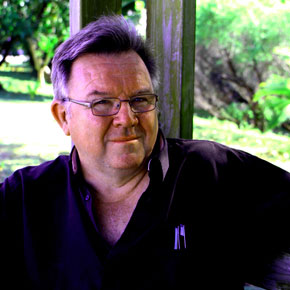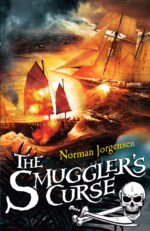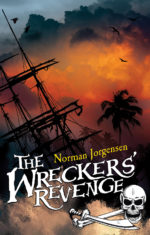Adventures on the Cocos Islands: writer Norman Jorgensen on what life’s like for schoolchildren on a tropical archipelago

I think it is important for fictional characters to live in real places, which is why I have set my stories in locations I have visited. Often an interesting-looking town – or island, in this case – can be the spark that inspires the whole story. The Cocos Islands, approximately 2,750 kilometres north-west of Perth, is one of the settings for my latest adventure story, The Wreckers’ Revenge.
Much of the plot involves my characters from The Smuggler’s Curse being shipwrecked there. I was on a Book Week visit to the schools when the shipwreck idea came to me one afternoon while I sat on a pristine white beach under a coconut palm tree.
There are 27 islands in the atoll, of which only two are inhabited. I spent time on Home Island and West Island with the Cocos Malay people, visiting their schools and spending time with the children who live on the islands. The Cocos Malay people are descendants of people from Malaya who were brought to the island back in the nineteenth century to work as semi-slaves on the coconut processing plant owned by the Clunies-Ross family. They have a strong Muslim faith and have managed to retain most of their customs even though they were cut off from the rest of the world for many years.
Life for schoolchildren there differs from that of children in other parts of Australia.
Getting to school
Unlike my character Red Read, who jumps aboard a boat to escape school, many kids of the Cocos Islands need boats to get to school. The fast ferry across the lagoon from Home Island to West Island gets the kids to school quickly and probably a lot faster than some of them would want.
I took the 20-minute journey from Home Island to West Island, where the high school is located, with everyone else – children, teachers, workers, government employees, nurses. It is just like taking a bus, so it’s no big deal to the islanders even though I thought of it as rather exotic. The ferry was reasonably new and quick – and watertight, thank goodness, as one day we sailed across in a raging storm, which concentrated the mind a bit.
Preparation for a different kind of life
The teachers are very aware that their children are isolated from the world of cities, towns and suburbs that children in Western Australia might be used to, and so they spend a lot of time making sure that island children are prepared to face the big wide world when they leave school. They go on camp to Perth and have many guest speakers at school to help them learn about the wider world. They use modern technology to keep in touch and don’t really feel cut off at all. Most kids have relatives in Perth, and many families fly back and forward. The locals love their tropical island, not surprisingly, and when children grow up, many stay and make good lives there. Wind surfing at Cocos is world famous too, so they have visitors from all over the world.
Food and shopping
Everyone on the islands eats a lot of freshly caught fish, but other fresh food can be a problem. Mostly they rely on monthly deliveries by ship from mainland Australia. Sometimes the ship is delayed by bad weather for weeks, so when it does arrive there are long lines for lettuces.
Malay cooking is amazing, though – fresh and full of all sorts of flavours. Many of the Europeans travel over to West Island for dinner, which can be a problem when they are enjoying themselves too much and miss the last ferry home.
Their recipes often involve coconuts, as they are in abundance. Unlike the olden days, they are no longer farmed and processed so there are now so many coconuts that the island is in danger of sinking under the sheer weight of them. Or that’s what I reckon anyway. Part of the reason I had my characters turn them into bombs was because they’re everywhere; the ground in the jungle is literally strewn with them. Blowing them up seemed like a good solution, though I’m sure my ‘wreckers’ were less than impressed.
Transport
There are no cars on West Island, so most families get about on electric golf buggies. However, the two inhabited islands are small enough to walk across if you don’t have one of these. I didn’t see any older children driving them, but would not be surprised at all if they did. There aren’t many cops there and the children seem to have plenty of freedom.
The few roads that there are, are good, or there are numerous sand tracks to ride on. The children have skateboards and they’ve just built a new skate park for them. We hired a scooter and zipped about on that, with no worries about other traffic on the roads except crabs and feral chickens that roam at will.
Spare time
Children on the island still have all the same things we do – mobile phones, computers, tablets, the internet. But there’s lots of adventure to be had outdoors too. Families seem to have two or three boats parked in their driveways and often travel to the smaller, uninhabited islands to spend the weekends away.
Lee Hegarty, a teacher at the school, looked after us really well, and apart from taking us to play golf on the airport runway – the longest golf fairway in the world – she also took us snorkelling in a channel that sweeps you along at great speed while you just lie on the surface of the warm water and watch the millions of fish swim past you. I loved it so much I used it in the book, where Red and Black Bowen float to another island to sabotage the wreckers’ lugger.
Traditions, culture and events
Being a small community, the locals are always organising events to get everyone involved and so there is a real warmth and friendliness in the air. I liked how the Muslim community’s traditions were respected and how they shared their festivals with people who consider themselves Christian or non-religious, inviting them for feasts and celebrations. The West Islanders respond by also sharing Christmas and Easter traditions.
Pat Yaki, a Malay teacher’s assistant, invited us to meet his family and share some traditions, and took us on a tour of West Island that included the cemetery. It was here that I saw the old grave which I decided was where William Dampier, the pirate, had buried his fabled lost gold. I won’t be laughing if I find out sometime in the future he actually did bury it there. But what’s $50 million between friends?
The Wreckers’ Revenge by Norman Jorgensen is available to pre-order from your bookseller or Fremantle Press now. For free teaching activities and bookmarks contact admin@fremantlepress.com.au.
Norman will be one of five children’s authors launching his book at the Great Big Book Read on Wednesday 22 May at ECU’s Spiegeltent. Tickets are free and this is a child-friendly event. Go to Eventbrite to secure your ticket today.








